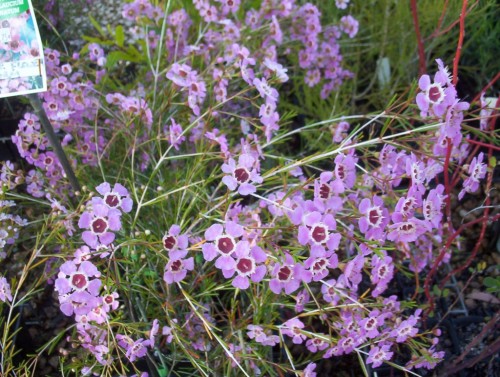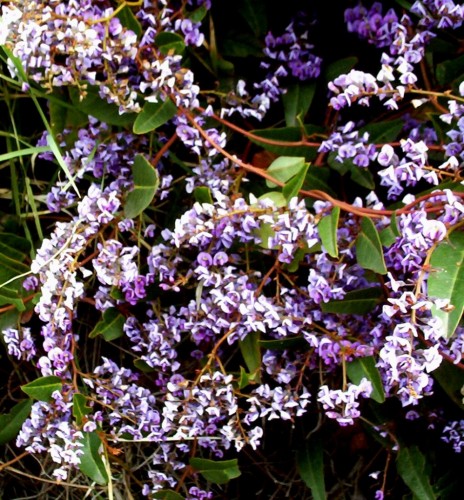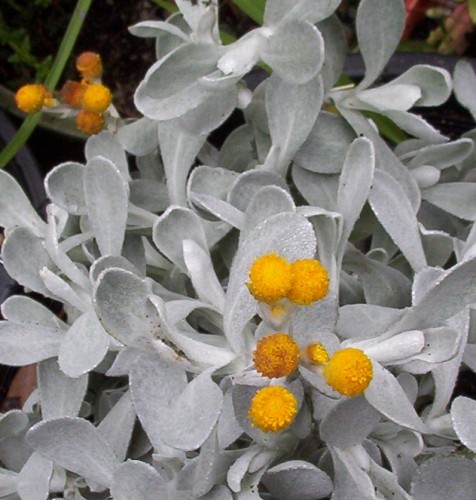Chamelaucium uncinatum (Geraldton Wax)
These must be the most popular plant grown for the cut flower industry. There are so many colours from white through pinks and mauves and wine shades to be used in flower arrangements. Flowering times vary from winter through to summer.
In general these are hardy in dry conditions once established. Unfortunately not all are frost hardy. Severe frosts will burn some back quite severely. Despite this they are large shrubs that are well worth growing as screen plants or wind break plants. Pruning consists of the equivalent of cutting the flowers on long stems. Many florists use the buds in floral arrangements followed by the flowers as they open.
Good drainage and a sunny open position and pruning give good results with these plants.
Hardenbergia violacea (Native Wisteria)
When a plant is as dense as this one is, some hedge clippers would probably do the pruning very well.
Although the flowering time is limited to about 2 months at the most, the creeper on the fence stays green and dense for the rest of the year.
There are white and pink forms of this plant. The pink is particularly pretty but does not seem to be as robust as the others.
Chrysocephalum apiculatum
These plants need tidying up when new growth begins at the base of the plants.
My favourites have grey/green leaves and one has distinctly grey leaves. Of course the flowers look great against these leaves. The mallee form is a small clumping plant, with smaller flowers and green leaves. It is a dainty plant compared to the brashness of the others.
Top 5 Drought Tolerant Australian Native Plants…
…in five categories.
I decided that I would set 5 simple categories of plants and list five species within those categories.
Drought Tolerance is relative and what I have chosen are plants that are drought tolerant in an area with less than 14 inches (350mm) of annual rainfall (winter wet). Other issues which can make a difference are severe frosts, drying winds, the amount of rainfall the previous winter and whether mulch is used or the amount of shade available.
Ground Covering Plants
- Hardenbergia violacea (purple, pink, white) Native wisteria (Also a climbing plant)
- Chrysocephalum apiculatum (suckering plant with small yellow pom pom heads.
- Kennedia prostrata (Running Postman – because of red and black flowers and very flat form.
- Eremophila glabra (Emu Bush) (various prostrate forms, different colours)
- Myoporum parvifolium vigorous flat ground cover with white flowers
Small Shrubs to 1 metre
- Eremophila macdonnellii (large deep purple flowers)
- Eremophila macdonnellii (large deep purple flowers)
- Prostanthera magnifica (Mint Bush with very large flowers)
- Thryptomene saxicola (Pink or white small flowers)
- Grevillea lavandulacea
Tufted Plants
- Dianella revoluta (Purple nodding flowers and purple berries)
- Orthrosanthos multiflorus (Native Iris) (Mauve Blue flowers)
- Wahlenbergia communis (native Bluebell) (perrenial with blue star flowers.)
- Calostemma purpureum (Native Lily) (Pink-red flowers)
- Anigozanthos flavidus (Kangaroo paw)
Shrubs to 3 metres
- Acacia drummondii (yellow rods)
- Banksia ornata
- Melaleuca wilsonii (red bottle brush flowers)
- Chamelaucium uncinatum (various colour forms)
- Hakea leucoptera (Honey Suckle) (Prickly bush with cream flowers)
Trees
- Eucalyptus campaspe
- Melia azedarach (White Cedar)
- Callistemon viminalis (Weeping Bottlebrush)
- Agonis flexuosa (Native Willow)
- Melaleuca lanceolata (White bottle brush flowers)
These are some of my favourite plants and ones that I know to be successful. These are all growing in garden conditions. Growing the same plants in the field is another matter altogether and another list would need to be generated.
I haven’t been able to get to my blog for several weeks and this opportunity to participate in the latest Problogger writing project provided me with the push to get going again.
Australian Native Plants for Seaside Gardens
This is the beginning of my list of plants suitable for seaside plantings. It is a good idea to use hedges or fences as wind breaks against the prevailing sea winds so that more tender plants can be planted on the lee side where they are less likely to be burnt by salt laden winds. Not having experience with this type of locality I am writing from observation, discussions with folk who do garden in this type of area and what I read.
I am choosing plants that are known to be also lime tolerant. My list also reflects drought tolerance. I will also have to do a list for those who do not need to worry about these other aspects.
Australian Native Plants for Seaside Gardens.
Shrubs
Acacia sophorae
Alyogyne hakiefolia
Banksia grandis
Banksia media
Banksia speciosa
Banksia spinulosa
Chamelaucium uncinatum
Correa alba
Correa backhousiana
Correa reflexa
Melaleuca armillaris
Melaleuca huegelii
Melaleuca hypericifolia
Melaleuca lanceolata
Myoporum acuminatum
Myoporum insulare
Myoporum viscosum
Olearia axillaris
Olearia glutinosa
Phymatocarpus porphyrocephalus
Rhagodia candolleana
Ricinocarpus pinifolius
Templetonia retusa
Westringea fruticosa


